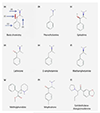Amphetamines, new psychoactive drugs and the monoamine transporter cycle
- PMID: 25542076
- PMCID: PMC4502921
- DOI: 10.1016/j.tips.2014.11.006
Amphetamines, new psychoactive drugs and the monoamine transporter cycle
Abstract
In monoaminergic neurons, the vesicular transporters and the plasma membrane transporters operate in a relay. Amphetamine and its congeners target this relay to elicit their actions: most amphetamines are substrates, which pervert the relay to elicit efflux of monoamines into the synaptic cleft. However, some amphetamines act as transporter inhibitors. Both compound classes elicit profound psychostimulant effects, which render them liable to recreational abuse. Currently, a surge of new psychoactive substances occurs on a global scale. Chemists bypass drug bans by ingenuous structural variations, resulting in a rich pharmacology. A credible transport model must account for their distinct mode of action and link this to subtle differences in activity and undesired, potentially deleterious effects.
Keywords: addiction; amphetamine; monoamine transporter; psychostimulant; regulation; reverse transport.
Copyright © 2014 The Authors. Published by Elsevier Ltd.. All rights reserved.
Figures




References
-
- Sulzer D, et al. Mechanisms of neurotransmitter release by amphetamines: a review. Prog. Neurobiol. 2005;75:406–433. - PubMed
-
- Biel JH, Bopp BA. Amphetamines: structure–activity relationships. In: Iversen LL, et al., editors. Handbook of Psychopharmacology: Stimulants. Plenum: 1978. pp. 1–40.
-
- Ross EA, et al. ‘Bath salts’ intoxication. N. Engl. J. Med. 2011;365:967–968. - PubMed
Publication types
MeSH terms
Substances
Grants and funding
LinkOut - more resources
Full Text Sources
Other Literature Sources
Molecular Biology Databases

